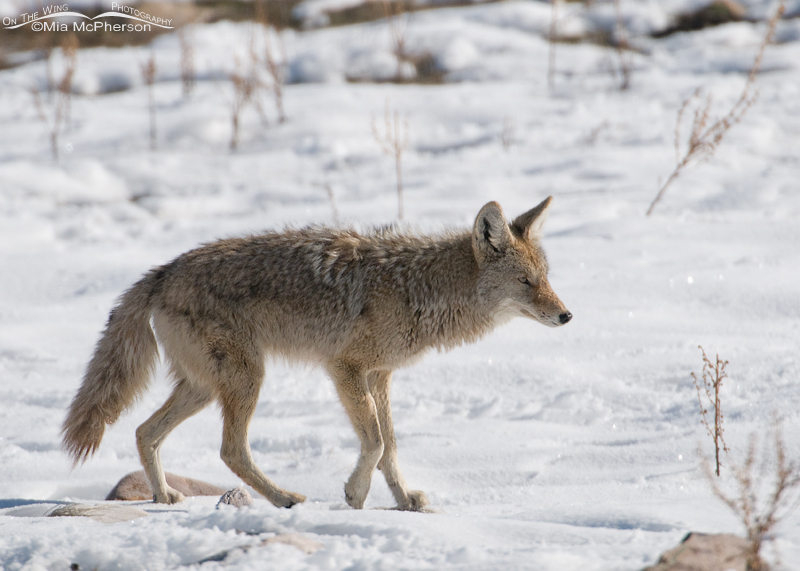 Injured female Coyote – Nikon D300, f6.3, 1/3200, ISO 640, +0.3 EV, Nikkor 200-400mm VR with 1.4x TC at 400mm, natural light, not baited or called in
Injured female Coyote – Nikon D300, f6.3, 1/3200, ISO 640, +0.3 EV, Nikkor 200-400mm VR with 1.4x TC at 400mm, natural light, not baited or called in
Yesterday I spotted a Coyote on Antelope Island, it was down a slope near a herd of Pronghorn and not in the best of light. I noticed almost right away that the Coyote was limping rather badly. I can’t guess as to how the Coyote sustained its injury but I hope that it will be okay.
Then I saw a second paler Coyote that had just crossed the road to the other side and realized that I had photographed this pair recently and that this was the female to the pale male I wrote about here. The female did not have an injured leg when I photographed them at the end of January.
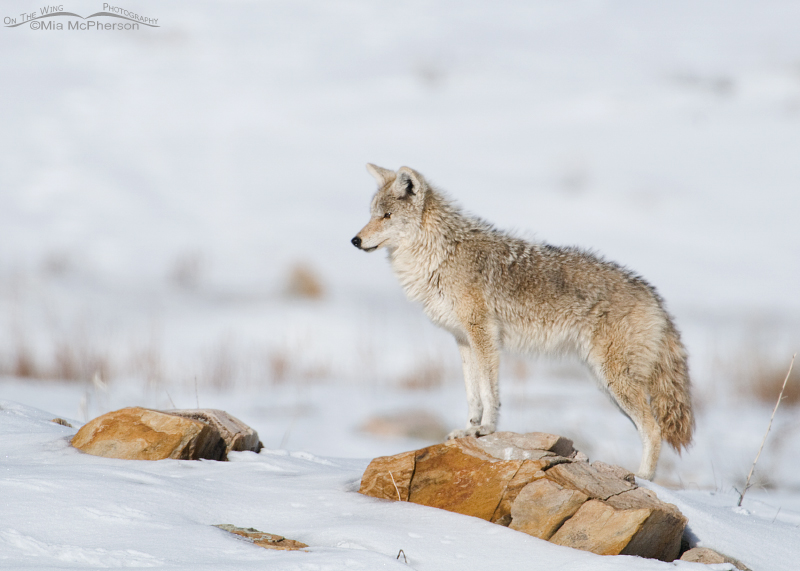 Pale male Coyote on a rock – Nikon D300, f6.3, 1/3200, ISO 640, +0.7 EV, Nikkor 200-400mm VR with 1.4x TC at 400mm, natural light, not baited or called in
Pale male Coyote on a rock – Nikon D300, f6.3, 1/3200, ISO 640, +0.7 EV, Nikkor 200-400mm VR with 1.4x TC at 400mm, natural light, not baited or called in
There was another car in the area and two people jumped out to photograph the pale male Coyote on the west side of the road which unsettled the Pronghorn herd. It is easy to see when that happens because they raise the light patches of hair on their rear ends. The female Coyote wasn’t bothering them at all as she struggled to walk in the snow, the Pronghorns were much more concerned about the people. The Coyotes were separated because of the road and also because the female wasn’t going to get close to the couple who had gotten out of their vehicle. The female Coyote then laid down in the snow and rested.
The pale male stood on a rock some times gazing towards where the female laid down and at other times just looked around.
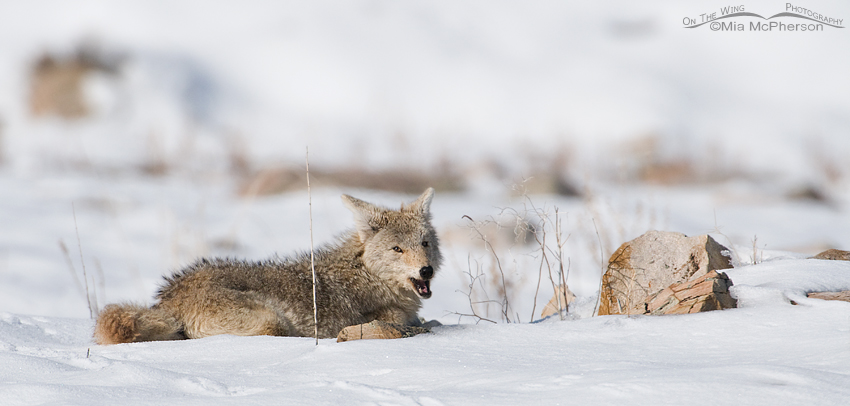 Male Coyote eating something while laying in the snow – Nikon D300, f7.1, 1/3200, ISO 640, +0.3 EV, Nikkor 200-400mm VR with 1.4x TC at 400mm, natural light, not baited or called in
Male Coyote eating something while laying in the snow – Nikon D300, f7.1, 1/3200, ISO 640, +0.3 EV, Nikkor 200-400mm VR with 1.4x TC at 400mm, natural light, not baited or called in
After the couple got back in their vehicle and left the male Coyote found what appeared to be a section of bones from the wing of a large bird behind the rock on the right side of this frame and it gnawed on those bones.
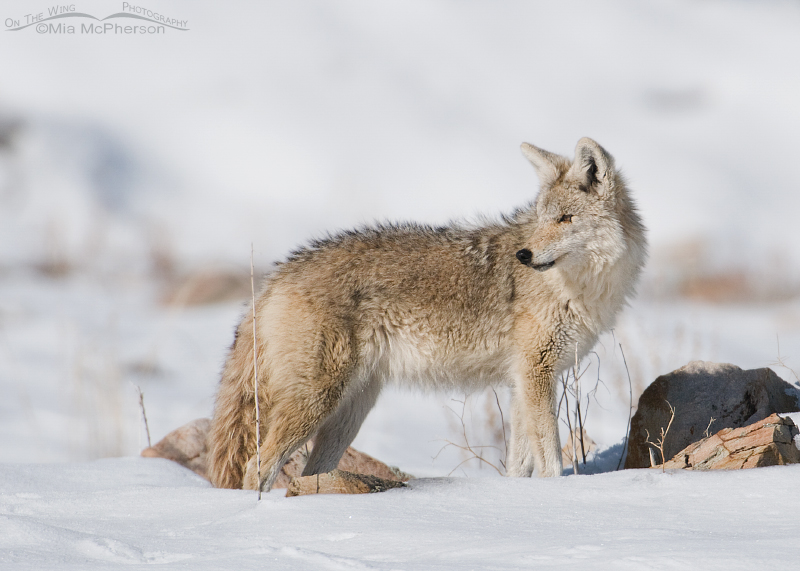 Male Coyote – Nikon D300, f7.1, 1/3200, ISO 640, +0.3 EV, Nikkor 200-400mm VR with 1.4x TC at 400mm, natural light, not baited or called in
Male Coyote – Nikon D300, f7.1, 1/3200, ISO 640, +0.3 EV, Nikkor 200-400mm VR with 1.4x TC at 400mm, natural light, not baited or called in
After the pale male Coyote was done gnawing on the bones it stood back up and looked around.
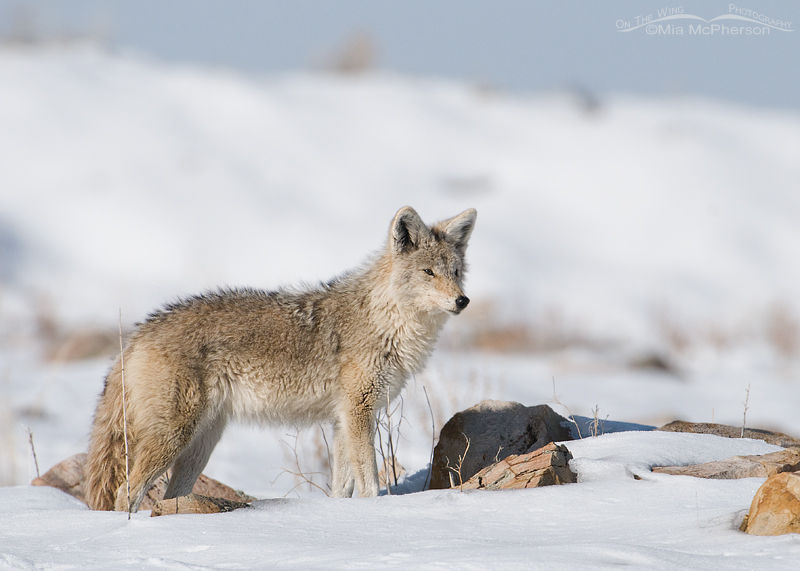 Coyote keeping a watchful eye – Nikon D300, f7.1, 1/3200, ISO 640, +0.3 EV, Nikkor 200-400mm VR with 1.4x TC at 400mm, natural light, not baited or called in
Coyote keeping a watchful eye – Nikon D300, f7.1, 1/3200, ISO 640, +0.3 EV, Nikkor 200-400mm VR with 1.4x TC at 400mm, natural light, not baited or called in
He was keeping an eye on his mate. As he slowly started to make his way up the hill I left because I didn’t want to keep them separated because of my presence. I’m sure the female will catch back up to the pale male or that he will circle back to rejoin her.
It is the policy of the park to allow nature to take its course so I didn’t report the injured Coyote to the park rangers, that is a policy I believe in and stand behind even when seeing an injury in an animal that tugs at my heart. And it does.
She may just have something lodged in the pad of her foot, I am just not sure. I’ll be looking for this pair of Coyotes in the future though.
Life is good.
Mia
Click here to view more of my Coyote photos plus facts and information about this species.


Thanks everyone for your comments on this Coyote post and the images.
Ingrid, I believe that the park will intervene if an animal has a human caused injury, for instance; if they get hit by a car. I can’t say that with absolute certainty though. I feel that is the least we can do when humans cause the issue.
I’ll keep an eye out for this female and do more posts on her if I can.
Great chronicle and superb photos. I look forward to seeing your images of the pair later this spring!
She could have an abcess from a bite wound. The cold will help keep inflammation down if she does. Beyond that, they are pretty tough. It could burst if she gnaws at it. Must be painful. If there were open water she could wade into … she might go for that, too. Sure hope she makes it.
Gorgeous photos. I love coyotes. I hope her foot heals…
Enjoyed reading your post, Mia. You narrate a story so well and accompany it with beautiful photos.
Sad but I know what you mean about “letting nature take its course.” I agree with Ingrid that humans only intervene when it is a problem caused by humans.Hope I will capture a shot of the coyote that frequents in the neighbourhood but from a good distance. I want it to stay wild.of course I appreciate your photos and the story.
Wonderful.
I love Coyotes. They are such beautiful creatures. Last night Kathie and I both spotted one near a campground with lovely coloring. Thanks for sharing your stories and yotes:)
Beautiful portrayal, Mia. I know many parks have this perspective. Do you know if the officials change their policy if the injury is human-inflicted? At our wildlife hospital, we took all manner of injury in wild animals. But the local field rescue where I trained did not intervene with natural events, only human-caused inflictions. In other words, they, as humans, intervened only when human intervention or technology caused the issue.
Great series and accompanying excellent picture/story of the events. Thanks Mia.
Very nice shots Mia and glad you shared the story behind them.
Hope she recovers quickly! I watched a red fox on its travels over a period of about 3 weeks last winter. On the first day I saw it, it was limping severely and was quite thin. I was worried it wouldn’t survive, but within a week its gait was back to normal and within two weeks it had gained weight and all was well. Wild animals are resilient, and with a watchful mate nearby, I’m hopeful that the female will make a full recovery.
Thank you Mia. I think it’s a hopeful sign, in spite of the of the female’s injuries, her mate (and you) are looking out for her. Hope she recovers quickly.
I hope all goes well for the injured coyote.
Great set!
How sad about the foot. I did see a bison once with a broke foot and I did call the center. I didn’t know they don’t do anything. Poor critters and the they go through. The bison couldn’t walk. I felt so bad.
beautifull serie, the white snow give a very nice background, thanks mia